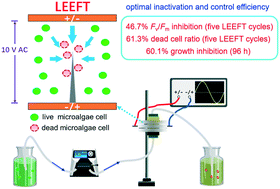Efficient microalgae inactivation and growth control by locally enhanced electric field treatment (LEEFT)†
Abstract
In recent years, locally enhanced electric field treatment (LEEFT) has been considered as a novel and promising technology for efficient microorganism inactivation. Previous studies were primarily conducted on bacteria and viruses. Here, polydopamine-protected copper-oxide-nanowire-modified copper mesh (PDA-CuONW-Cu) electrodes were fabricated and utilized in a flow-through LEEFT device to treat two microalgae species, Chlorella vulgaris and Microcystis aeruginosa. The results showed that the LEEFT achieved efficient microalgae inactivation and growth control. The inhibition of Fv/Fm was 46.7% and 34.3% for C. vulgaris and M. aeruginosa, respectively, after five LEEFT cycles at a flow rate of 1.2 mL min−1 and a 10 V alternating voltage with a frequency of 104 Hz. Fluorescence staining and flow cytometry measurements verified the inactivation of microalgae cells, with dead cell ratios increasing to 61.3% and 56.5% for C. vulgaris and M. aeruginosa, respectively. Both species could still grow after removing the electric field, indicating that the LEEFT is a physical treatment process without residual anti-microbial effects. Nevertheless, with five LEEFT cycles, the 96 h-growth inhibition reached 60.1% and 66.2% for C. vulgaris and M. aeruginosa, respectively. The LEEFT can still be a promising control method for microalgae blooms when the LEEFT electrodes are durable enough for long-term circular treatment.

- This article is part of the themed collection: Nanomaterial applications in water


 Please wait while we load your content...
Please wait while we load your content...